

- #Check point vpn 1 securemote secureclient how to
- #Check point vpn 1 securemote secureclient install
- #Check point vpn 1 securemote secureclient license
- #Check point vpn 1 securemote secureclient plus
- #Check point vpn 1 securemote secureclient professional
The administrator can pre-configure the client's installation and configuration settings, such as the connection mode to the VPN Security Gateway (Connect/Transparent), encryption properties and more. The administrator can then distribute the package to the users. Packaging Tool combines a client installation package (for example, the generic SecureClient installation package) with a package profile to create a preconfigured SecureClient package.
#Check point vpn 1 securemote secureclient professional
#Check point vpn 1 securemote secureclient install
Users can then use the configured package to install the software without being required to configure details, ensuring that users cannot inadvertently misconfigure their SecureClient software. The SecureClient Packaging Tool enables the administrator to create pre-configured SecureClient installation packages. The Check Point Solution - SecureClient Packaging Tool Overview This tools must enable the administrator to preconfigure the software, so that users do not have to do this themselves. The administrator's task is even more difficult if the organization has several groups of users, each of which requires a different configuration.Īdministrators need a tool to automate the configuration of software to large user communities. Users often lack the technical expertise to configure the software themselves, requiring administrators to provide support for large numbers of users, many of whom may be geographically dispersed and using a wide variety of platforms. The Check Point Solution - SecureClient Packaging ToolĪs remote access to organizations becomes more widespread, administration of the remote client software becomes more difficult.

In order to find out how many there are of those and subtract them to leave only IPsec VPN clients (i.e.Introduction: The Need to Simplify Remote Client Installations
#Check point vpn 1 securemote secureclient license
This includes SNX users with OM IPs as well, who take up from a different license (MAB). The above output (#VALS=1 ) means currently one client is assigned an OM IP. HOST NAME ID #VALS #PEAK #SLINKS localhost om_assigned_ips 372 1 1 0 You can also run the following command on the gateway, in order to see the number of OM IPs which are currently assigned by the gateway: To see the username of each "connected" remote access user (in the last 15 minutes), run this command (in Expert mode) on VPN Security fw tab -t userc_rules -f To see the number of currently connected Remote Access users, run this command (in Expert mode) on the VPN Security fw tab -t userc_users -s
#Check point vpn 1 securemote secureclient how to
Listusers - Shows a list of end-users connected to the gateway, along with their source IP addresses.īut that is not all as we can look into the kernel tables :įrom sk39034: How to check the number of currently connected Remote Access users and sk14496: How to check the names of remote access users that have sent traffic through the Security G. There is no supported tool that can check it like "dtps lic" for new endpoint client, but MAB has its own CLI command, see Mobile Access Administration Guide R77 Versions pp.
#Check point vpn 1 securemote secureclient plus
MAB licenses are defined as the number of concurrent clients and MAB even has five grace clients, so the maximum number of concurrent clients is the number of licenses plus five. The "old" RA VPN client licensing worked by counting client IPs (called "seats", CLI "dtps lic" on policy server), and the used licenses count showed the number of clients that did connect during the last 30 days. I am sorry, but your question is not fully understandable - so i just provide some basic information:


 0 kommentar(er)
0 kommentar(er)
